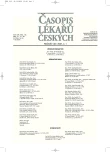-
Medical journals
- Career
Incidence of Hiatal Hernias in the Current Endoscopic Praxis
Authors: J. Ténaiová; L. Tůma; K. Hrubant; R. Brůha; T. Švestka; A. Novotný; J. Petrtýl; V. Jirásek; P. Urbánek; K. Lukáš
Authors‘ workplace: IV. interní klinika 1. LF UK a VFN – Gastroenterologické centrum, Praha
Published in: Čas. Lék. čes. 2007; 146: 74-76
Category: Original Article
Overview
Background.
Hiatal hernia represents penetration of the oral part of stomach together with the distal part of oesophagus via oesophageal hiatus into the thoracic cavity. On the basis of endoscopic examination hiatal hernia is defined as circular pull out of the gastric mucosa longer then 2 cm from the diaphragm to Z line, measured at the end of examination during removing the endoscope. Hiatal hernia is usually an acquired state which can worsen oesophagitis by holding refluxate and thus by prolonging the duration of purgation.Methods and Results.
Endoscopic and radiological studies show that 50 to 94 % of patients with gastroesophageal reflux disease have an axial hiatal hernia while in control persons the incidence fluctuates between 13 % and 59 %. Hiatal hernia is a frequent finding during upper gastrointestinal endoscopy. Hernia can contribute to the development of reflux into the proximal oesophagus. A cohort of one thousand patients (18 to 94 years) who underwent upper gastrointestinal endoscopy was analysed retrospectively. Endoscopy was performed between January and June 2005 at the Endoscopic center of the 4th Medical Department of the University Hospital in Prague.Conclusions.
Presented study has shown that in patients who underwent endoscopy, hiatal hernia occurs in 16.6%, more frequently in men (53.6%). The most common type is an axial hiatal hernia with incidence of 94.58%. In 50% of patients with hiatal hernia the reflux oesophagitis of various degrees was diagnosed.Key words:
hiatal hernia, reflux oesophagitis, gastroesophageal reflux disease.
Labels
Addictology Allergology and clinical immunology Angiology Audiology Clinical biochemistry Dermatology & STDs Paediatric gastroenterology Paediatric surgery Paediatric cardiology Paediatric neurology Paediatric ENT Paediatric psychiatry Paediatric rheumatology Diabetology Pharmacy Vascular surgery Pain management Dental Hygienist
Article was published inJournal of Czech Physicians

-
All articles in this issue
- Needfulness and Mission of Health Edu
- To the Fourties Anniversary of the Pancreatic Transplantation
- Lower Dyspeptic Syndrome Recommended Diagnostic and Therapeutic Practice for General Practitioners 2006
- Effect of Hypolipidemic Treatment on the Composition of Bile and the Risk or Cholesterol Gallstone Disease
- Orthopaedic Treatment of Osteolytic Lesions in Long Bones of Multiple Myeloma Patients
- Postoperative Pulmonary Thromboembolism and Nosocomial Pneumonias: Differential Diagnosis
- Prognostic Impact of Matrix Metalloproteinases 2,9, and 11 in Stromal Cells Stage I Non-small Cell Lung Cancer
- Cardiac Surgery Operations and Their Influence on Serum Level of Antiinflammatory Cytokine Interleukin-10
- Cohort of Lymphedema Patients Followed at the Lymphology Centre of the Dermatovenerologcal Clinic of the 2nd Faculty of Medicine University Hospital Na Bulovce Prague in Years 2000 to 2005 A Retrospective Study
- The p53 Positivity in Non-tumor Mucosa in Patients with Superficial Urinary Bladder Cancer
- HIV/AIDS and Pathology in Blood Count
- Incidence of Hiatal Hernias in the Current Endoscopic Praxis
- A Rare Complication of Acute Lymphoblastic Leukaemia in Young Patients
- Incidence of Delirium Tremens in the Czech Republic: A Rapid Increase
- Journal of Czech Physicians
- Journal archive
- Current issue
- Online only
- About the journal
Most read in this issue- Lower Dyspeptic Syndrome Recommended Diagnostic and Therapeutic Practice for General Practitioners 2006
- HIV/AIDS and Pathology in Blood Count
- Incidence of Hiatal Hernias in the Current Endoscopic Praxis
- Postoperative Pulmonary Thromboembolism and Nosocomial Pneumonias: Differential Diagnosis
Login#ADS_BOTTOM_SCRIPTS#Forgotten passwordEnter the email address that you registered with. We will send you instructions on how to set a new password.
- Career

